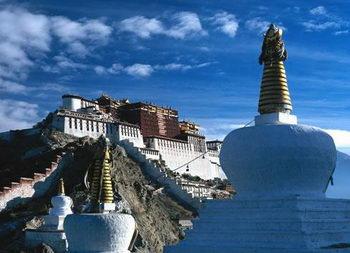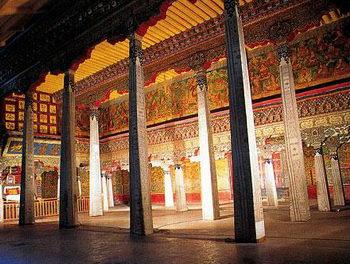Source: CCTV.com
04-04-2008 09:45
Special Report: Tibet TodayThe Potala Palace in Lhasa is Tibet's architectural icon, and has been placed on the world cultural heritage list. It has been under renovation since 2002 and is expected to be finished this year. Meanwhile, the Central Government has allocated additional funds to protect other cultural relics and temples in Tibet.
 |
|
Photo of Potala Palace |
The Potala Palace was constructed more than 1300 years ago, and has been rebuilt and expanded several times. No one is quite sure exactly how many rooms, Buddhist Sutras and cultural relics lie within its walls.
To protect this Buddhist holy site, the Central Government decided to give the palace an overall renovation in 2002.
This is the traditional Tibetan way of working, repairing the floor with all natural materials while singing together. The process is complicated, but the workers keep using this way to renovate.
The mural painting is another key aspect of the renovation. Over two hundreds experienced workers from Dunhuang Research Institute have undertaken this huge project.
Qamba Galsang, director of Potala Palace management office, said "Our principle is to renovate the old palace while maintaining authenticity. Our dyestuffs are all mineral, which gets brighter as time goes on. "
According to the process of the project, the whole renovation work will be finished this year.
 |
|
Photo of Potala Palace |
Other major cultural heritage sites in Tibet such as Norbu Lingka and Sagya Monastery are also involved in the renovation work.
Vice-chairman of Tibet regional gov't Baema Chilain said "During the 10th five-year plan, the Central Government allocated 330 million yuan to protect these three cultural heritage sites. Another 700-800 million yuan will be put into during the 11th five-year plan. The next step is to renovate the Jokhang Temple and other major temples. This is to protect cultural relics and protect the religion."
From 2008, another 22 cultural relics and temples in Tibet will be renovated, including Tashilhunpo Monastery, Zhaibung Monastery and Sera Monastery.
Now there are over 1400 temples and monasteries, cultural monuments and places of religious activity open to the public.
Under the policy of free religion, the pilgrims can pray at any time.
Editor:Yang Jie
